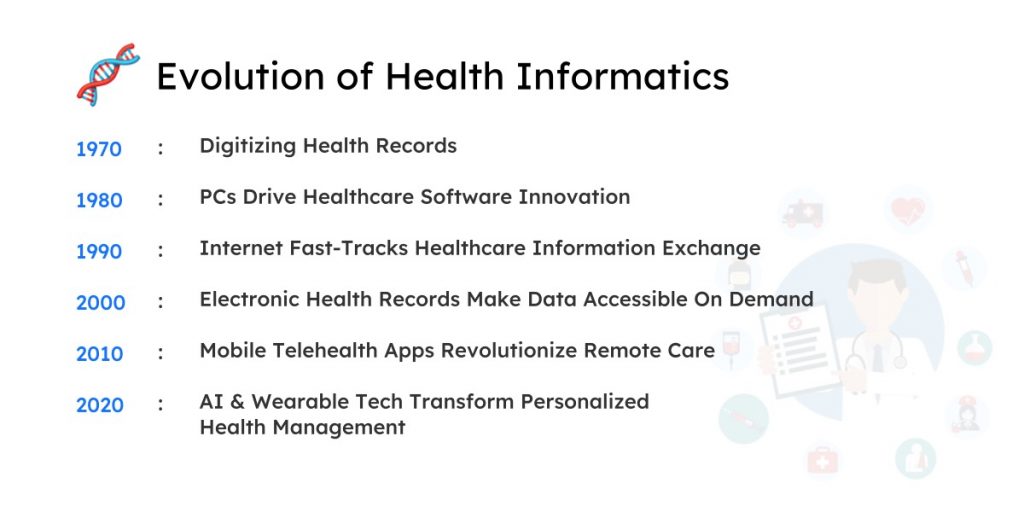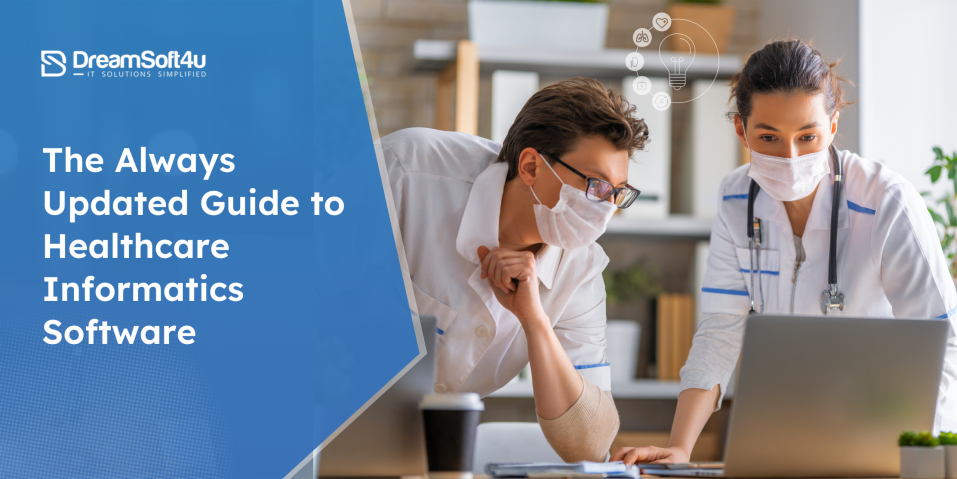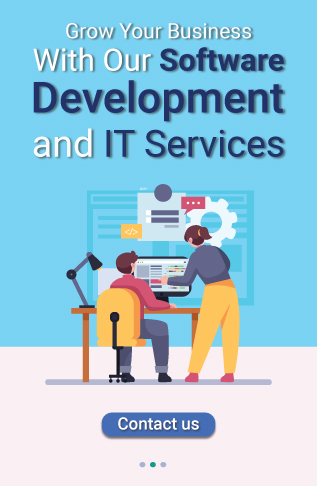The current state of healthcare is characterized by an ongoing data flood and an increasing focus on digital effectiveness. A key component of this revolution is healthcare informatics software, which gives clinicians the means to improve patient care, streamline processes, and glean insightful information from enormous medical databases. For healthcare workers at every stage of their employment, this thorough reference is a useful resource.
We’ll give you a clear and simple overview of the many software options available, deconstructing their features and helping you through the decision process to guarantee you discover the best fit for your requirements. Furthermore, this guide will show you the latest trends in the market and keep you updated with recent development techniques and ideas. Additionally, find out the enhancement and advancement in the healthcare informatics Software. Join us on the journey of the healthcare world to explore the Importance of healthcare informatics software and realize its full potential for your practice.
Table of Contents
ToggleWhat is healthcare informatics?
In simple terms, it is the use of technology to gather, store, and analyze large volumes of health data. Also referred to as a health information system or health informatics, the primary goal of healthcare informatics is to enhance diverse healthcare touchpoints. This includes patient-provider engagement, remote care, patient experience, care quality, and outcomes.
How big is healthcare informatics?
Today, we are already witnessing health informatics impact through:
- Electronic health records
- Telemedicine
- Wearable devices and mobile health apps.
- Precision medicine and much more
Moving forward, it will be essential for healthcare providers, small and big, to integrate health informatics. If you are reading this and wondering where to start? Don’t worry!
This guide will walk you through everything you need to know about healthcare interoperability informatics.
Trends in Health Informatics

Today, Artificial Intelligence, Machine Learning, Virtual Reality, and Augmented Reality are powering wearables and mobile apps to reshape healthcare informatics. For example, custom healthcare software is being used in,
- AI aids in diagnosis and personalized treatment
- VR/AR simulate procedures, aids education
- Wearables provide health data and advice
- Mobile tech connects patients and providers
Key Components of Health Informatics
The key components of health informatics include:
Electronic Health Records (EHRs) and Electronic Medical Records (EMRs)
EHRs and EMRs are digital copies of a patient’s medical records. They allow providers and patients to access health information in real-time using their mobile devices. Overall, these digital record system helps improve care and coordination.
Health Information Exchange (HIE)
While EHRs and EMRs allow health records to be shared between providers and their patients, HIEs facilitate the sharing of health information across organizations. For example, a provider can access patients’ records from other providers to get a more complete health history.
Telemedicine and Remote Patient Monitoring
Telemedicine connects patients and providers remotely using instant messaging and video conferencing. On the other hand, remote patient monitoring measures patients’ health vitals such as blood pressure and glucose levels.
Healthcare Analytics and Big Data
The data generated by EHRs, HIEs, and other sources are leveraged using analytics to uncover insights that improve care, reduce costs, and enhance the patient experience. Predictive analytics can even help providers anticipate health issues before they arise.
Artificial Intelligence (AI) and Machine Learning
AI and machine learning can analyze big data, detect patterns and make predictions in healthcare. Some examples include AI that can analyze medical scans to detect diseases, and virtual assistants that can handle routine patient questions and tasks.
Why use Healthcare Informatics?
In the digital age, Healthcare EHR Interoperability generates massive data, from patients to operations. Healthcare informatics taps into this resource, enabling efficient management and improved care.
Through specialized software, healthcare organizations can analyze patient records, billing, and operations for cost savings, enhance services, and improve patient satisfaction. Some of the major benefits of healthcare informatics include:
Streamlined Patient Care:
With patient health data at their fingertips, providers can create personalized care plans for patients, ensuring effective treatments and improved outcomes.
Efficiency and Cost Reduction:
Automation of administrative tasks and data analysis minimizes costs. It helps optimize scheduling, reduce re-admissions, unnecessary tests, and eliminates redundancies.
Enhanced Productivity:
Digitization of processes, workflows, and data management, reduces workloads, eliminates paperwork, and allows more time for patient interaction.
Informed Strategic Decisions:
Advanced analytics convert data into actionable insights, guiding organizational strategies based on cost trends, care quality, patient satisfaction, and population health.
Patient Data Management:
Secure informatics systems centralize patient records, ensuring authorized access across locations and departments.
Improved Care Coordination:
Centralized patient information enhances coordination between providers, reducing errors and conflicting treatments.
Population Health Insights:
Aggregated patient data aids in understanding population health trends, guiding resource allocation, and wellness programs.
Efficient Hospital Operations:
Data-driven insights optimize resource allocation, patient flow, and budgets, supporting strategic planning and decision-making.
Effective Billing and Reimbursement:
Informatics software automates billing processes, minimizing errors and ensuring accurate reimbursement.
Leveraging healthcare informatics optimizes operations, enhances services, and improves care quality while lowering costs, resulting in better healthcare outcomes for all.
Use cases for Healthcare Informatics
When it comes to use cases, Healthcare informatics applications can be broadly categorized as Clinical and Managerial.
1. Clinical Implications
Clinical informatics streamlines processes and data flow. Online portals, EHR systems, and RPM devices bridge traditional barriers and facilitate the seamless exchange of health data between the patient and providers. Further, with nursing informatics, the data can be shared with healthcare software development teams for more efficient and collaborative care.
2. Managerial Implications
While clinical informatics is focused on hassle-free data sharing and exchange, managerial informatics is centred around secure health data storage and management. Efficient healthcare information technology streamlines tasks, optimizes time management, and ensures swift completion of responsibilities.
Types of Healthcare Informatics
Healthcare informatics has many sub-categories of software and systems. Here are a few of the major ones:
A. Biomedical Informatics
Biomedical informatics focuses on integrating and analyzing biological data, medical images, and clinical information. It aids in research, diagnostics, and personalized treatment.
B. Public Health Informatics
Public health informatics addresses population health issues. It helps in disease surveillance, health promotion, and policy development by deciphering complex biological systems and their interactions.
C. Laboratory Informatics
Laboratory informatics optimizes laboratory operations. It enhances accuracy and efficiency in research and diagnostics, enabling seamless tracking of samples, results, and experimental processes.
D. Pharmacy Informatics
Pharmacy informatics streamlines medication management. It also ensures safe and effective medication use through electronic prescription systems, drug interaction alerts, and medication history records.
E. Medical Informatics
Medical informatics focuses on managing and utilizing medical data to improve patient care and outcomes. It involves electronic health records, clinical decision support systems, and telemedicine applications.
F. Bioinformatics
Bioinformatics in understanding genetic sequences, protein structures, and molecular interactions. It helps in advancing drug discovery, genomics, and personalized medicine.
G. Nursing Informatics
Nursing informatics enhances communication and coordination among healthcare teams. It involves tools tailored to fit seamlessly into nursing workflows, promoting efficient patient care and collaboration.
These various types of healthcare informatics play essential roles in improving healthcare delivery, research, and patient outcomes.
Role of Healthcare Informatics in Patient Care
Healthcare informatics software plays an increasingly important role in providing high-quality patient care. Providers rely on informatics tools and systems for:
Maintaining patient records: Electronic health records (EHRs) and electronic medical records (EMRs) document patient visits, track medical history, and ensure continuity of care.
Enabling information exchange: Health information exchanges (HIEs) and other interoperability solutions facilitate sharing of patient data, resulting in better-coordinated care.
Improving clinical decision-making: Providing diagnosis and treatment suggestions based on the latest evidence-based guidelines reduces medical errors and improves outcomes.
Increasing efficiency: Healthcare informatics streamlines workflows reduces paperwork and cuts down on redundant tests and procedures. It lowers costs and enables healthcare staff to spend more time with patients.
Future of Healthcare Informatics and How it Can Transform the Healthcare Sector?
As healthcare informatics continues to advance, it will transform how care is delivered. The following trends will drive healthcare informatics in the future:
Wider adoption of electronic health records (EHRs) and health information exchanges (HIEs) to facilitate seamless sharing of patient data.
Growth of telehealth and remote patient monitoring. More people will access care through virtual visits and use wearable devices that transmit health data 24/7.
Improved data analytics and artificial intelligence. Advanced algorithms will uncover insights from huge amounts of health data to enhance diagnosis, predict outcomes, and personalize treatment plans.
The future is digital, data-driven, and patient-centered. Healthcare Informatics will provide the data and tools to measure health outcomes, reduce readmissions, and cut waste. It will help usher in a new era of higher quality, more affordable, and accessible care.
Things to Remember when choosing healthcare informatics software
When evaluating healthcare informatics software, keep these key points in mind:
A. Meeting Your Needs: Avoid the mistake of focusing on dreams instead of needs. Get what you require, not what you hope for, to prevent overspending or mismatched systems.
B. Immediate Solutions: Address current issues before future plans. Invest in a system that tackles ongoing problems rather than banking on future needs that might leave you unprepared.
C. Vendor Stability: Check vendor stability and history. Financial security matters. Verify their stability through agreements and records to ensure a long-lasting partnership.
D. Start Small: Buy for the need at hand. Begin with a single module, and expand as you see benefits. Adapt and grow over time.
E. Learn from Others: Study past mistakes. Avoid common pitfalls, and plan for your new system’s success during the redesign. Prevention is cheaper than retrofitting.
F. Flexible Hardware: Choose adaptable hardware. Research and ask the vendor for hardware that suits your evolving needs.
G. Collaborative Decision: Involve various departments in the decision. Information services and purchasing departments should participate, but make the final choice independently.
H. Get it in Writing: Ensure promises are documented. Written agreements guarantee the promised quality of your biomedical and health informatics system.
I. Support and Maintenance: Clarify post-agreement support. Don’t be left alone after signing. Discuss ongoing support and maintenance with the vendor.
J. Interoperability: Ensure compatibility with other systems. Seamless data transfer between hospital and clinical systems is crucial for preventing errors and ensuring efficient integration.
Also Read: Solving Healthcare’s EHR Interoperability Problems through bespoke software solutions
How DreamSoft4u can help in implementing custom healthcare informatics technologies?
In the dynamic world of healthcare, harnessing the power of custom informatics technologies is essential for effective patient care and research advancements. But navigating the intricate landscape of software development can be challenging, especially for healthcare organizations with patient-critical tasks in hand.
At DreamSoft4u, we understand the unique hurdles that healthcare professionals and researchers face when crafting tailor-made solutions. Let’s explore how DreamSoft4u can help you overcome these challenges.
Critical Requirements Challenge and Sustainability Aspects:
Creating software solutions that meet both functional and regulatory requirements can be intricate and time-consuming. DreamSoft4u eases this burden by fostering collaboration between experts and offering tools that emphasize documentation, portability, and code reusability. Our adherence to FAIR principles amplifies the trustworthiness of your software, whether you’re aiming for academia or industry.
Long-Term Maintenance and Software Development Planning:
Sustaining the vitality of your healthcare information management system beyond the initial launch demands careful planning and structured processes. DreamSoft4u ’s well-defined software development plans provide a roadmap that aligns with your project’s objectives, ensuring that every aspect, from deliverables to risk control, is meticulously accounted for.
Software Requirements Analysis and Software Architecture:
Crystal-clear requirements are the bedrock of a successful medical informatics project. At Dreamsoft4u, we excel in translating your needs into precise software requirements, eliminating ambiguity, and promoting efficiency. Crafting an architecture that aligns with your vision, while also being adaptable, ensures a solid foundation for your solution’s growth.
Implementation, Testing, and Verification:
Translating your vision into fully functional health informatics software is often filled with technical intricacies. With DreamSoft4u ’s expertise in implementation, unit testing, and rigorous verification, your software evolves from a concept to a robust reality.
Software Release and Legacy Software:
Releasing your software to the world requires meticulous planning, documentation, and adherence to industry norms. Whether you’re navigating the academic realm or venturing into the industry, DreamSoft4u ensures that your software stands up to scrutiny and evolves gracefully over time.
Configuration and Change Management:
Managing the changes that inevitably arise in software development can be challenging. DreamSoft4u assists you in establishing well-structured change management processes, bolstering usability, and traceability throughout your software’s life cycle.
Looking to build a feature loaded Healthcare Informatics Software?
At DreamSoft4u we transform your ideas into reality
Conclusion:
Explore the updated guide and find out information about the latest resource for staying up to date on the newest developments in healthcare informatics software. Check out the latest updates and all the essential details that clarify your question regarding healthcare informatics Software. Also get further updates on the latest tools and new technologies that might benefit your healthcare business. Remember that the appropriate software may alter how you provide care, streamline workflows, and enable you to make data-driven choices for the benefit of your patients. Let this book serve as a springboard into the future of healthcare informatics, where technology integrates seamlessly with patient care, maximizing results and moving the industry ahead.
FAQs
Q1 What are the different types of healthcare informatics software?
There’s a wide range! From Electronic Health Records (EHRs) that manage patient data to Telehealth platforms enabling virtual consultations, and even software for medical imaging and lab results. This guide will break down the most common types and their functionalities.
Q2: How can healthcare informatics software improve patient care?
Healthcare informatics Software and benefits the patient in multiple ways as it improves communication gap between physicians and patients. Additionally it provides necessary medication, and speeds up access to medical information. Overall it results in more informed decisions and better health outcomes.
Q3: What are the most important aspects while selecting healthcare informatics software?
Your individual demands are important. Consider budget, usability, compatibility with current systems, and security considerations. This guide will lead you through each stage and help you discover the best fit.
Q4: Is adopting healthcare informatics software a complicated process?
It can be, but this guide is here to assist! We’ll give a step-by-step implementation plan, from software selection to employee training and transfer.
Q5 How will this software impact my workflow and daily tasks?
The good news is that healthcare informatics software typically improves processes. It eliminates monotonous activities, improves data organization, and gives real-time access to information, allowing you to devote more time to what is most important: your patients.





















